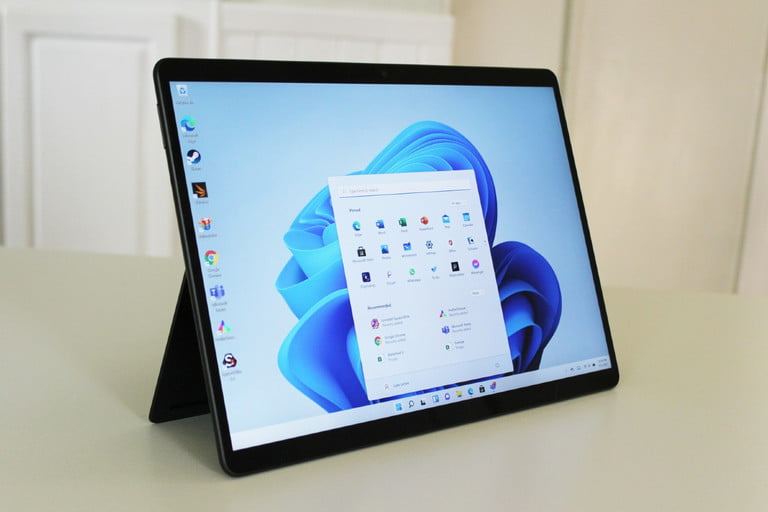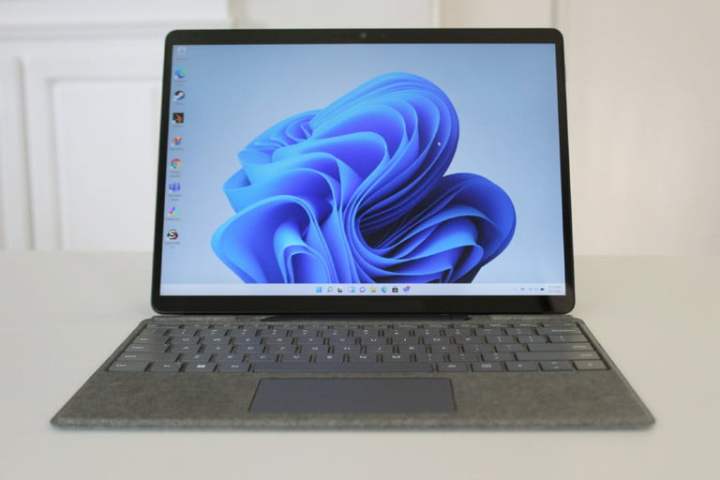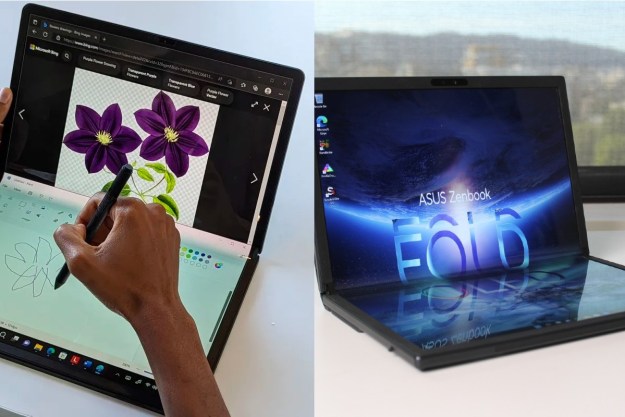The Lenovo ThinkPad X12 Detachable is a great detachable tablet that took over the top spot on our list of best 2-in-1s. It beat out the Microsoft Surface Pro 7, which had a great run but got a little long in the tooth.
Enter the Surface Pro 8, which was released in early October 2021 and makes some meaningful and long-overdue improvements to the Surface Pro line. Can the ThinkPad X12 Detachable keep its place on top against the new and improved Surface Pro 8?
Specs
| Lenovo ThinkPad X12 Detachable | Microsoft Surface Pro 8 | |
| Dimensions | 11.15 inches x 8.01 inches x 0.34 inches | 11.3 inches x 8.2 inches x 0.37 inches |
| Weight | 1.67 pounds | 1.96 pounds |
| Processor | Intel Core i3-1110G4 Intel Core i5-1130G7 Intel Core i5-1140G7 with vPro Intel Core i7-1160G7 Intel Core i7-1180G7 with vPro |
Intel Core i5-1135G7 Intel Core i7-1185G7 |
| Graphics | Intel UHD graphics Intel Iris Xe graphics |
Intel Iris Xe graphics |
| RAM | Up to 16GB | Up to 32GB |
| Display | 12.3-inch 16:10 Full HD+ (1920 x 1280) IPS 60Hz | 13-inch 3:2 2880 x 1920 IPS 120Hz |
| Storage | Up to 1TB solid-state drive (SSD) | Up to 1TB |
| Touch | Yes | Yes |
| Ports | 1 x USB-C 3.2 Gen 2 1 x USB-C 4 with Thunderbolt 4 1 x 3.5mm audio jack 1 x Nano SIM slot (optional) |
2 x USB-C with Thunderbolt 4 1 x Surface Connect 1 x 3.5mm audio jack |
| Wireless | Wi-Fi 6 and Bluetooth 5.1 | Wi-Fi 6 and Bluetooth 5.1 |
| Webcam | 720p | 1080p |
| Operating system | Windows 10 Home or Pro | Windows 11 Home |
| Battery | 42 watt-hour | 51.5 watt-hour |
| Price | $2,016+ | $1,399 |
| Rating | 3.5 out of 5 stars | 4 out of 5 stars |
Design
The Surface Pro 8 maintains the same basic shape and excellent integrated kickstand as the Surface Pro 7, only with more rounded corners and smaller display bezels. The latter allowed Microsoft to squeeze in a larger display, 13-inches versus 12.3-inches, requiring the slightest increase in size and thickness. In addition, Microsoft switched from magnesium to recycled aluminum, adding just a smidgeon of weight. As before, the Surface Pro 8 is available in Platinum and Graphite colors.

The ThinkPad X12 Detachable also adopts the iconic look of its line, with the usual ThinkPad all-black chassis with just a few red accents such as the LED dot over the “i” on the front logo and the red TrackPoint nubbin and red-striped buttons on its detachable keyboard. Lenovo borrowed Microsoft’s kickstand, extending from the center of the tablet’s backside like the Surface Pro 8 and allowing the tablet to lie almost flat on a surface. The ThinkPad X12 Detachable also enjoys the same soft-touch coating over its magnesium casing as other ThinkPads, making it very comfortable in hand.
The two tablets are close in width and depth, with the Surface Pro 8 being just a little thicker than the ThinkPad X12 Detachable at 0.37 inches versus 0.34 inches. It’s also heavier at 1.96 pounds versus 1.67 pounds. As mentioned above, the Surface Pro 8 benefits from its smaller display bezels in managing to fit a larger display into a similarly sized chassis.

Both tablets are incredibly well built. You won’t find any bending, flexing, or twisting with either the Surface Pro 8 or the ThinkPad X12 Detachable — both feel like solid fusions of metal and glass. Lenovo subjects its ThinkPads to military-standard durability testing, but that doesn’t really give it an advantage over the Surface Pro 8. These are premium machines through and through.
Connectivity is similar between the two tablets. The Surface Pro 8 (finally) includes two USB-C ports with Thunderbolt 4 support, the proprietary Surface Connect port, and a 3.5mm audio jack. The ThinkPad X12 Detachable offers one USB-C port, one USB-C port with Thunderbolt 4, a 3.5mm audio jack, and a nano-SIM slot for optional WWAN support. Wi-Fi 6 and Bluetooth 5.1 perform wireless duties on both, while the ThinkPad X12 Detachable supports optional 4G LTE WWAN.
Keyboard and pen

The Surface Pro 8’s detachable keyboard is optional and extra cost, either the $179 Signature Type Cover or $179 Surface Pro X Type cover, both of which are similar. They’re covered with Alcantara fabric for extra comfort, and the keyboards enjoy deep travel with snappy and precise switches. There’s some bounce when you have the keyboard magnetically attached at an angle, but it’s not egregious. The ThinkPad X12 Detachable’s keyboard is included, and it utilizes a smaller version of the usual ThinkPad keyboard with its sculpted keys and excellent ThinkPad mechanism with its own deep travel and precise (if stiffer) switches. The ThinkPad’s keyboard is also more solid, with less bounce than Microsoft’s version — although that extra solidarity makes for a thicker package when the keyboard is attached. At the same time, the Surface Pro 8’s keyboards include a dock for the Surface Slim Pen that both charges it and provides a convenient place to store it. You’re limited to a simple loop on the ThinkPad to hold the rechargeable pen.

Both detachable keyboards include touchpads, and they’re both excellent. They support Microsoft’s Precision Touchpad drivers and are of a decent size, although the Lenovo loses some space to accommodate the buttons for the TrackPoint nubbin embedded in the middle of the keyboard. You get an extra way to control the cursor with the ThinkPad X12 Detachable if you happen to like the TrackPoint, but that’s unlikely to sway all but the most ardent ThinkPad lovers.
Finally, both tablets have responsive touch panels that support their respective active pens. The $130 Surface Slim Pen 2 is also optional, and it’s excellent with 4,096 levels of pressure sensitivity, tilt control, and a new haptic motor that simulates the actual feel of writing and drawing on a piece of paper. The ThinkPad X12 Detachable includes the Lenovo active pen with 4,096 levels of pressure sensitivity, but you need to spend $60 to upgrade to the next level pen for tilt control. Microsoft’s pen is unique in its haptic motor, and it has a handy dock for storing and charging, making it both more functional and convenient.
Performance

The ThinkPad X12 Detachable uses a range of lower-power 11th-gen Intel Core CPUs that run slower and at a lower thermal design power (TDP). Our review unit was equipped with the Core i5-1130G7 version, and it provided decent productivity performance. The Surface Pro 8 uses full-power 11th-gen Core processors, and our review unit was equipped with the Core i7-1185G7. It, too, provides good productivity performance.
Looking at our benchmarks, there’s not a huge difference in most tests between these two tablets. In Geekbench 5, the ThinkPad X12 Detachable scored 1,325 in the single-core test and 4,796 in the multi-core test, compared to the Surface Pro 8 at 1,296 and 5,041. In our Handbrake test that encodes a 420MB video at H.265, the Lenovo took 188 seconds, and the Microsoft took 185 seconds. Looking at the PCMark 10 Complete test, the ThinkPad X12 Detachable was faster at 4,443, with the Surface Pro 8 scoring 4,169. The ThinkPad was faster in the Essentials and Productivity portions of the benchmark but fell behind in the Content Creation portion. The only meaningful CPU difference was in Cinebench R23, where the Surface Pro 8 hit 1,287 in the single-core test and 5,431 in the multi-core test, compared to 1,125 and 3,663.
The Surface Pro 8’s version of the Intel Iris Xe graphics was faster than the ThinkPad X12 Detachable’s, doubling the 3DMark Time Spy test at 1,828 compared to 926. That means that you’ll be able to play modern games on the Surface at higher frame rates than you will on the ThinkPad, although neither will suffice as gaming machines.
Overall, the Surface Pro 8 is slightly faster than the ThinkPad X12 Detachable, but most users likely won’t tell the difference in the usual productivity tasks. If your workflow doesn’t include heavy content creation tasks, you’ll be fine with either of these tablets.
Display

One area where the Surface Pro 8 excels over the ThinkPad X12 Detachable is in its display. As mentioned above, Microsoft increased the size of the Surface Pro 8’s 3:2 aspect ratio display from 12.3 inches to 13 inches while giving it a resolution of 2880 x 1920. That’s good for 267 pixels per inch (PPI), much sharper than the ThinkPad X12 Detachable’s 12.3-inch display at Full HD+ (1920 x 1280) that comes in at 188 PPI.
The Surface Pro 8’s display also performed slightly better according to our colorimeters. In its “Vivid” setting, it hit 406 nits of brightness, blowing out our 300-nit threshold for good displays and a 1,010:1 contrast ratio that’s just above our preferred 1,000:1. Its colors were slightly above the premium laptop average at 79% of AdobeRGB and 99% of sRGB, with a color accuracy of DeltaE 1.4 (less than 1.0 is considered excellent). The ThinkPad X12 Detachable’s display put out 364 nits, had a contrast ratio of 940:1, color width of 77% of AdobeRGB and 99% of sRGB, and a color accuracy of DeltaE 1.59.
The Surface Pro 8 display’s most standout feature, though, is its ability to run at 120Hz (although 60Hz is configured by default). That makes every motion on the screen smoother and faster, with better animations, scrolling, and inking.
Both tablets are great for productivity work, and neither will provide the colors that creative types demand. Still, users will appreciate the Surface Pro 8’s larger display, extra sharpness, and smoother response.
Portability

Both tablets are small and light enough that you’ll barely notice them in your backpack. That’s true even with their keyboards attached. And both are great for use as actual tablets, including for inking, although the Surface Pro 8’s extra weight is noticeable.
In terms of battery life, the Surface Pro 8 benefits from a larger 51.5-watt-hour battery compared to the ThinkPad X12 Detachable’s 42 watt-hours. Of course, the Surface Pro 8 also has a larger, higher-resolution display and a full-power CPU. Looking at our battery tests, these tablets are equally matched when it comes to longevity.
The Surface Pro 8 lasted for 8.5 hours in our web browsing test compared to the ThinkPad X12 Detachable at eight hours. In our video test that loops a Full HD Avengers trailer, both laptops were close to 11 hours. Those tests are close enough to call this one a draw, and both tablets can get you through a full working day as long as your tasks aren’t too intense.
Conclusion
When we reviewed the ThinkPad X12 Detachable, it started at $1,100 for a Core i3-1110G4 CPU, 8GB of RAM, and a 128GB SSD. The Lenovo site currently lists that configuration at $2,016 without the usual discounts you’ll find in their configurator. Clearly, that’s an extremely high price, and I suspect the discount will appear again and the price will return to its “normal” level. At the high end right now, you’ll spend $3,140 for a Core i7-1180G7 with vPro, 16GB of RAM, a 1TB SSD, and WWAN support.
The Surface Pro 8’s pricing is more straightforward, with an entry-level price of $1,100 for a Core i5, 8GB of RAM, and a 128GB SSD. At the high end, you’ll spend $2,600 for a Core i7, 32GB of
The ThinkPad X12 Detachable enjoyed its day in the sun, beating out the Surface Pro 7. But the Surface Pro 8 changes the game, providing a better display with superior inking and an overall design that makes it the best detachable tablet you can buy.
Editors' Recommendations
- Best Lenovo laptop deals: Save on Yoga and ThinkPad laptops
- This tiny ThinkPad can’t quite keep up with the MacBook Air M2
- Why the latest ThinkPad X1 Yoga Gen 8 isn’t worth the upgrade
- Microsoft Surface Pro 9 vs. Lenovo IdeaPad Duet 5i: which 2-in-1 is best?
- The Surface Pro 9 embraces ARM chips and a splash of fresh color


